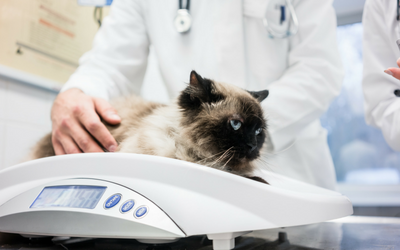
August 22nd is “Take Your Cat to the Vet Day” – a day to remind all cat owners to take their kitty to the veterinarian! Only 50% of cats make the trip to see their veterinarian every year. In contrast, the proportion of dogs that make the trip is 78%! While you may think that you’re doing your cat a favor by not “stressing him out” with a veterinary visit, cats are getting the raw end of the deal. Wellness checks are a crucial part of keeping your cat healthy.
During a wellness check, your veterinarian will assess your cat’s health (by performing a full physical examination), screen for obesity and make nutritional recommendations, ensure that vaccinations are up-to-date, perform a fecal analysis and prescribe a dewormer if necessary, prescribe a flea and tick preventive, and, as your cat ages, perform senior screening tests to detect early stage illness or disease. Prevention and early treatment are often less costly than waiting until there is a full-blown problem.
Your veterinarian will assess your cat for the following common feline health problems:
- dental disease
- heart murmur
- feline upper respiratory infection
- cystitis (inflammation of the bladder)
- obesity
- fleas
The veterinary visit provides you with the opportunity to voice any concerns you may have, such as changes in eating, sleeping, or activity, and weight gain/loss. Even subtle observations on your part can help your veterinarian uncover hidden issues, issue that are not problematic at the moment, but could be in the future if left untreated.
Keep in mind that cats age more quickly than humans. A one-year-old cat is approximately 15 in human years and a two-year-old is about 24! Each year thereafter is equivalent to about 4 years. A lot can happen or change “in a cat year,” so taking your cat for yearly wellness checks is important.
The frequency of these checks depends on the status of your cat’s health. Your veterinarian will recommend a schedule with your cat’s best interests in mind.
Don’t let stress prevent you from taking your cat to see your veterinarian. A few inventive steps prior to the visit may reduce the stress. Leave your cat’s carrier out as an alternative (and even preferred) sleeping spot, making it as comfy as possible with familiar blankets. If your cat only goes in the car to see the vet, consider going on random car rides to reduce the association of the car with a veterinary visit.
Check with your clinic to see what they suggest to keep your cat as calm and happy as possible.
Be an advocate for your cat’s health and well-being, just as you are for your own. An ounce of prevention is worth a pound of cure. This month, take your cat to the vet. She may not say “Thank you,” but her health and happiness is thanks enough!